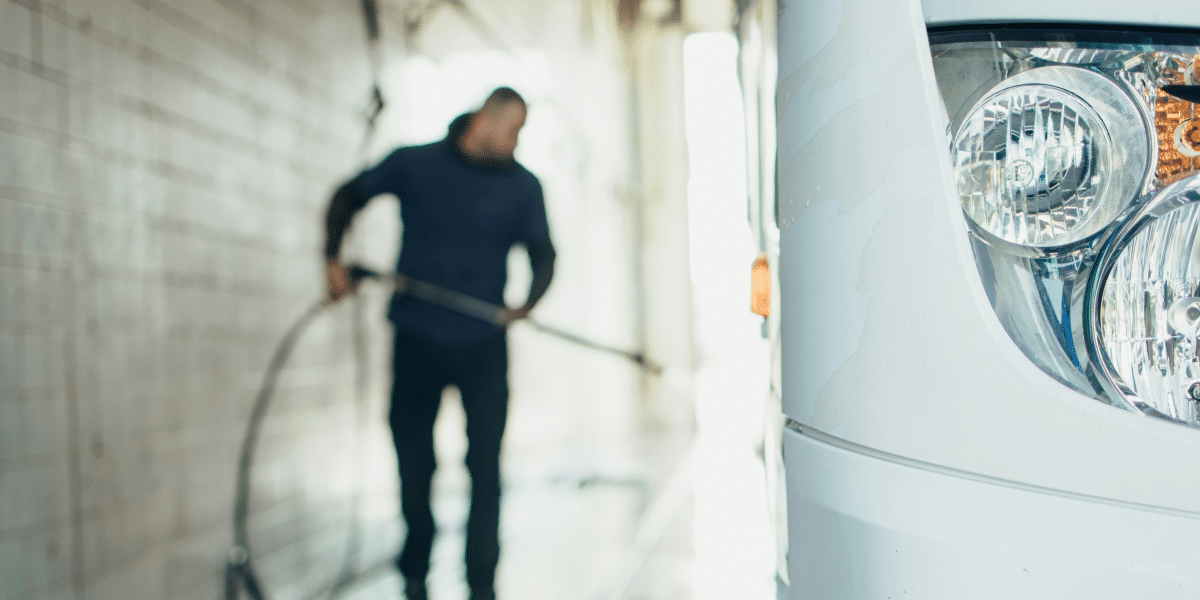Pressure washing sounds simple—just point, spray, and watch the grime disappear, right? It’s not that simple! While it’s a powerful way to clean just about anything, one wrong move can easily ruin your cleaning efforts and turn your day into a disaster.
Before starting with pressure washing, it is important to understand what is effective and what is not.
We’re breaking down the dos and don’ts of pressure washing and covering everything from simple DIY projects to more advanced tasks. Keep reading to ensure your pressure washing is safe, effective, and frustration-free!
The Dos of Pressure Washing
Pressure washing can transform dirty surfaces in no time, but doing it right takes a bit of know-how.
1. Always Prioritize Safety
Pressure washers pack a punch, so your safety should always come first. Wear gloves, goggles, and sturdy shoes to protect yourself from flying debris and slippery surfaces. Double-check the equipment for leaks or damage before turning it on. Always keep the nozzle pointed away from people, pets, and fragile items to prevent accidents.
2. Prepare the Area
Before you start, clear the area of loose items like furniture, toys, or plants. Cover anything delicate with a tarp to shield it from high-pressure water or cleaning solutions. A clutter-free workspace not only protects your belongings but also makes the job easier and faster.
3. Use the Right Equipment
Match the surface you are cleaning with the appropriate pressure settings and nozzle type. Wood materials function well under low-pressure conditions, whereas concrete is able to utilize the proper tools, ensuring that work is done effectively and securely. Additionally, be sure to verify the compatibility of the detergent when using cleaning solutions to prevent any chemical accidents.
4. Test Before You Commit
Begin by trying out the pressure washer in a small, inconspicuous spot. This assists in determining the correct pressure and method without putting the visible damage at risk. Testing at the beginning can prevent the need to correct expensive errors down the road.
5. Move the Washer Consistently
Keep the nozzle moving in smooth, even strokes. Staying in one spot for too long can cause streaks or even damage the surface. Consistency ensures the surface is cleaned evenly and avoids unnecessary wear on materials.
6. Clean in Sections
Break down your cleaning task into smaller parts to prevent overlooking areas. This method guarantees a complete clean without causing you to feel stressed. Breaking the task into smaller parts helps track progress and reduces stress.
The Don’ts of Pressure Washing
Pressure washing might look easy, but a few wrong moves can turn your cleaning mission into a messy disaster.
1. Don’t Use Excessive Pressure
High pressure might seem like the ultimate cleaning hack, but it can cause serious damage to delicate surfaces like wood, siding, or painted areas. It’s often better to call in professionals who have the experience and equipment to get the job done safely and effectively. They’ll ensure a thorough clean without risking costly repairs.
2. Don’t Skip Maintenance
A poorly maintained pressure washer can lead to leaks, uneven spray, or even equipment failure. Always check hoses, nozzles, and connectors before starting. Ignoring maintenance might save time initially but could lead to mid-job setbacks.
3. Don’t Overdo Detergents
Too much detergent won’t make the surface cleaner; it’ll just leave a sticky mess or harm nearby plants and grass. Follow the manufacturer’s instructions for dilution and rinse thoroughly to avoid residue buildup.
4. Don’t Ignore Weather Conditions
Pressure washing on windy or rainy days isn’t just inconvenient—it can reduce visibility and blow water or debris where it shouldn’t go. Stick to calm, dry conditions for better results and a safer experience.
5. Don’t Assume Every Job is DIY
Certain jobs, such as cleaning tall roofs or eliminating stubborn stains, call for specialized tools and expertise. Attempting these tasks on your own may result in injuries or unsatisfactory outcomes. Understand your boundaries, and if unsure, seek help from a specialist.
DIY vs. Hiring Professionals: How to Know?
Some pressure washing tasks are perfect for a DIY approach, especially if you are comfortable handling the equipment. Cleaning driveways, patios, and garden furniture are great starting points. These surfaces can usually handle a moderate pressure setting without much risk of damage. Just follow the basic dos and don’ts, and you will get the job done efficiently.
However, certain cleaning jobs require professional expertise, such as that of a local pressure washing company near you, to avoid damage and ensure thorough results. According to Daniel, the Owner of Pressure Washing America, LLC in Houston, Texas, surfaces like roofs, multi-story buildings, or delicate materials like vinyl siding or painted walls are better left to experts.
Stubborn mold, oil stains, or grime on large commercial spaces also call for professional-grade equipment and techniques. Hiring pros means peace of mind and spotless results without the hassle.
Conclusion
Pressure washing is an incredible way to refresh surfaces, but it’s all about knowing what to do and what to avoid. Understanding the basics can save you from costly mistakes. Your property shines without the stress or risk. So, roll up your sleeves for the easy jobs and leave the heavy-duty cleaning to those who do it best!
Published by: Nelly Chavez

















